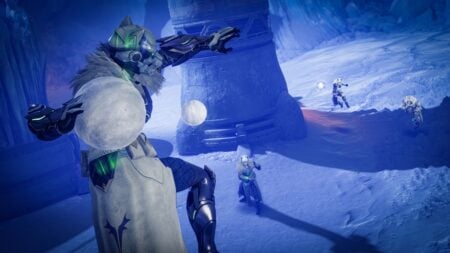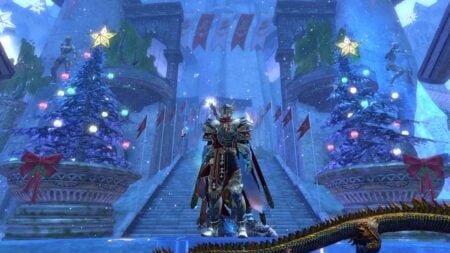Skip To...
Armored Core VI: Fires of Rubicon is not Elden Ring with robots. That’s a weird disclaimer but a necessary one. As the first FromSoftware game to release since Miyazaki’s last masterpiece, fans are clamoring to know how much Souls DNA appears in the new mech title. Add too much, and you lose what makes Armored Core the franchise it is. Yet it would be foolish not to learn from and incorporate at least some of the genius ideas used in the other FromSoftware games. There’s a magic balance that must be found, and Miyazaki found it. If one phrase defines ACVI, it’s “brutal but fair.”
Armored Core VI Review: Marvelous Mechs
A sizable campaign, Arena mode, and PvP in the Nest offer players plenty of opportunities to flex their mech piloting skills. Assemble a giant robot from numerous parts, study your opponents, perfect your strategy, and complete your mission. In typical FromSoftware fashion, the game will kill you over and over again until you learn and adapt. The magic of AC games has always felt like the magic of LEGOs. You dump a bunch of pieces out on the floor and let your imagination go to work building something great. Failure is a constant companion, but when everything comes together, there’s nothing quite as exhilarating.
Story: A World on Fire
Even hardcore fans will admit AC lore is a bit of a mess. The series has been reimagined multiple times, producing a handful of timelines that happen to share a few things in common. Thankfully, Fires of Rubicon is a fresh start with a new story and characters. The player steps into the shoes of 621, an Armored Core pilot who takes the codename “Raven” from a fallen merc. 621 takes their orders from the mysterious Handler Walter, who plays a big part in things to come.
The story reveals itself through cutscenes, mission briefings, comms chatter, and occasional documents. Fires of Rubicon throws a lot of factions and codenames at you. At first, it’s a little overwhelming as you learn to identify the big players behind the scenes. Fans of Miyazaki’s fragmented storytelling and the military-industrial conspiracies of previous AC games will be pleased. For gamers who grew up theorycrafting mech builds in their bedrooms, there’s something homey and nostalgic about this brand of story. This is military-industrial conspiracy as mac and cheese, and it is perfection.
Rubicon, a planet on the fringes of civilized space, has become a spark point for conflict thanks to a coveted energy source known as Coral. The same weapon manufacturers that outfit the player with new gear also employ private armies to advance their own corporate interests on Rubicon. Arquebus and Balam are just two of the factions at play here, however. From the idealists of the Rubicon Liberation Front to the Dosers drug gang, there are a lot of groups involved. Over the course of the campaign, the player gets a chance to work for (and against) basically all of them.
From Gundam to Neon Genesis Evangelion, mech games love stories about rogue corporations and endless militarization. At first, 621 is little more than a puppet of Handler Walter. Who Walter is, why he gives the orders he does, and how he connects to plot elements like Coral is a slowly unfolding mystery. Loyalty here is mercurial. One mission has the player assaulting the Dosers. Another has them uniting against another, larger threat. It’s nothing like the open-world freedom of Elden Ring, but the player has meaningful opportunities to direct the story.
If you don’t care about any of the deeper conspiracies and worldbuilding, Armored Core VI is still a great game. For those that do, however, there are plenty of pieces to put together, and it will take multiple playthroughs to unpack everything. Mediocre writing sometimes hampers the dialog, but even the occasional half-hearted line is performed well by the talented cast of voice actors. The storytelling isn’t revolutionary, but it’s a decent, shiny version of what AC fans expect.
The story is divided into chapters, and progressing through those chapters is essential to unlocking new content. Completing missions rewards players with money to purchase new parts, and completing chapters adds a bunch of new components to the shop. It’s a satisfying feedback loop: blow stuff up to get better guns to blow up bigger stuff. Progressing the story also unlocks new levels in the Arena, a 1v1 battle mode that pits players against AI mechs.
Gameplay: Tuned to Perfection
Balancing mech games is a nightmare. If the mech is too fast and fluid, you feel like a ninja instead of a giant robot, and the entire vibe is off. If the mech is too slow and cumbersome, an overemphasis on realism turns the game into a miserable slog. Steel Battalion is a cautionary tale in this case, and AC games have struggled with this balance before. The good news is that when it comes to fun, feeling, and difficulty, Fires of Rubicon is the best balanced in the entire series.
Managing two weapons, shoulder equipment, a scanner, boosters, energy expenditure, target alerts, and crucial HUD info is demanding. It never feels excessive, though. Turning around in older AC games felt as clunky and awful as the old Resident Evil tank controls. ACs in Fires of Rubicon jet across the battlefield in a blur, making mid-air micro-adjustments with their thrusters to dodge incoming missiles. Even tank builds can circle-strafe their opponent while smothering them with minigun fire. There’s no other way to say it: playing ACVI feels good. As a longtime fan of Armored Core and mech games in general, this is the gameplay experience I have always dreamed of.
Every choice you make with your mech feels meaningful. The bipeds, reverse-joints, tanks, and tetras from previous games are back, and they all feel unique. Pick a light body, punchy booster, and sword to play as a hummingbird of death, slashing enemies to ribbons before they can land a shot. Pack on beefy armor and missiles in every weapon slot, and obliterate your foes with a ceaseless volley of rockets. As you climb the Arena ranks, you unlock OST Chips to further tweak your mech. Do you want higher kinetic damage? How about a deployable shield? ACVI lets you build your way.
The influence of Miyazaki and the Souls games is evident in combat. To kill the game’s tougher bosses, the player must study their opponent and adapt accordingly. Yes, you can beat turrets and MTs just by having bigger guns and thicker armor. Many enemies, however, demand more of you. Some bosses are melee demons. Others can fly. Some have shields that laugh at one damage type but buckle under others. A few bosses play like environmental puzzles, testing the player’s spatial awareness. By the end of the game, you’ll either be an ace pilot or die trying.
Fires of Rubicon arguably shares more in common with Sekiro than the other Souls games. Hitting an enemy builds an Impact meter, and filling the meter stuns the enemy, opening them up for a string of critical hits. Getting comfortable with this mechanic is crucial because you’ll never beat certain bosses without it. Boss fights are an intricate dance of managing impact, reloads, and weapon cooldowns. Battles almost never feel unfair. Every time I died to the same boss a dozen or more times, I knew I had messed up. The game always rewards clever strategies and attention to detail.
QoL improvements like mid-mission resupplies and Assembly changes encourage experimentation. Not having to replay a tough mission from the beginning just because you brought the wrong gun is a massive relief. It’s the equivalent of having a Site of Grace right before a boss in Elden Ring. Being able to adapt mid-mission, swapping guns or other parts at checkpoints, feels amazing. FromSoftware understands that if you want to reward experimentation with builds, you can’t punish players for exploring their weird and occasionally questionable ideas. Armored Core VI is a beautiful testament to that.
Graphics & Audio: Sound and Fury
A blue beam of crackling energy slices through the snowy air. Beyond the skyscrapers rises a massive wall of concrete and steel lined with turrets. That’s where the shots are coming from. That’s where you’re flying, boosters roaring as you dart through enemy fire. You pull the trigger on your bazooka, and the satisfying thunk is followed a moment later by an explosion as the turret explodes. 11 turrets to go. In moments like this, the graphics and audio of ACVI can’t help but immerse the player.
Weapons and parts are all beautifully modeled. No matter what you equip, it’s going to change your AC’s appearance in a satisfying way. When so much of the gameplay hinges on building a cool robot, solid graphics and audio are a must. Thankfully, FromSoftware nails them both. Enemies are similarly fantastically designed. From the biggest set-piece boss to the lowliest guard, they all look good and fit the lore.
What about Core aesthetics? Every external part and weapon can be painted. Custom emblems can be crafted and applied. Dirt and rust can be applied on top of the paint. Want a shiny, neon-pink mech like a 12-ton mechanized Barbie doll? No problem. Want something gunmetal gray and rusted like it just crawled out of a junkyard? You got it. Stomping across the battlefield with a machine that’s been customized down to the last rivet scratches a particular kind of itch for AC fans.
Settings don’t vary much from past entries in the franchise. Abandoned cities, industrial rigs, and deserts make up most of the battlegrounds where these giant robots clash. Nothing here is revolutionary. Armored Core VI simply takes the environments that players expect to see and gives them a pleasant polish. The ingenuity won’t blow anyone away, but the execution is good without exception. It’s hard to ask for much more.
Conclusion: FromSoftware’s Newest Gem
After finishing the last chapter and grinding to S Rank in the Arena, I still had zero crashes and no bugs. As far as I can tell, FromSoftware has polished ACVI to the same standard as its other blockbuster titles. Some bugs will inevitably surface once more players get their hands on the game, but I experienced no red flags. The only area of uncertainty is the Nest (the game’s PvP arena). It won’t come as a surprise to anyone if something needs a hotfix when servers go live as players pile in, but that’s true of any major launch.
So how good is the game? The campaign is excellent. The Arena is fun, though maybe too easy with certain builds. Many fans, however, will see those modes as just the prologue for the real meat of the game: PvP. Considering the numerous possible builds and high skill ceiling, PvP should rank amongst the best the franchise has to offer once players learn the ropes.
Theorycrafting better mechs and perfecting one’s piloting skills will take some players hundreds or thousands of hours. Assuming the game attracts enough players to support it, PvP will likely become the game’s defining experience. Destroying AI bots is a blast, but it doesn’t compare to triumphing over another player with a custom-built machine. Fortunately, FromSoftware has crafted a deep and rewarding experience that gives players every reason to keep coming back for more.
Armored Core 6: Fires of Rubicon is available for PC (reviewed), PlayStation 4, PlayStation 5,
Review copy given by Publisher.
Armored Core VI: Fires of Rubicon (PC Reviewed)
Stylish and crunchy mech action with a campaign and customization that keep on giving.
Pros
- Top-tier combat
- High replayability
- Fantastic AC customization
Cons
- Uneven difficulty spikes
- Some problematic mission designs











